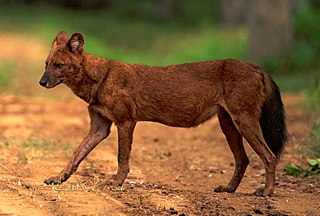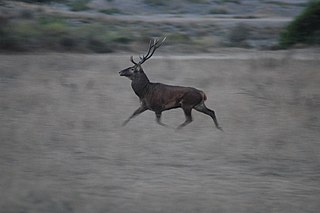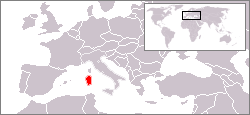
Canidae is a biological family of dog-like carnivorans, colloquially referred to as dogs, and constitutes a clade. A member of this family is also called a canid. The family includes three subfamilies: the Caninae, the extinct Borophaginae and Hesperocyoninae. The Caninae are known as canines, and include domestic dogs, wolves, coyotes, foxes, jackals and other species.

The dhole is a canid native to Central, South, East and Southeast Asia. Other English names for the species include Asian wild dog, Asiatic wild dog, Indian wild dog, whistling dog, red dog, red wolf, and mountain wolf. It is genetically close to species within the genus Canis, but distinct in several anatomical aspects: its skull is convex rather than concave in profile, it lacks a third lower molar and the upper molars sport only a single cusp as opposed to between two and four. During the Pleistocene, the dhole ranged throughout Asia, Europe and North America but became restricted to its historical range 12,000–18,000 years ago.

The Sardinian pika is an extinct species of lagomorph that was endemic to the islands of Sardinia, Corsica and neighbouring Mediterranean islands until its extinction likely in Roman times. It was last surviving member of Prolagus, a genus of lagomorph once widespread throughout Europe during the Miocene and Pliocene epochs, whose closest living relatives are pikas of the genus Ochotona.

Myotragus is an extinct genus of goat-antelope in the tribe Caprini which lived on the Balearic Islands of Mallorca and Menorca in the western Mediterranean until its extinction around 4,500 years ago. The fossil record of Myotragus on the Balearic Islands extends over 5 million years back to the early Pliocene on Mallorca, where it presumably arrived after the evaporation of the Mediterranean Sea during the Messinian Salinity Crisis.

Palaeoloxodon falconeri is an extinct species of dwarf elephant from the Middle Pleistocene of Sicily and Malta. It is amongst the smallest of all dwarf elephants at only 1 metre (3.3 ft) in height. A member of the genus Palaeoloxodon, it derived from a population of the mainland European straight-tusked elephant.
Mammuthus lamarmorai is a species of mammoth which lived during the late Middle and Late Pleistocene on the island of Sardinia in the Mediterranean. M. lamarmorai is a dwarf species, as it is estimated to have reached a shoulder height of only 1.4 metres (4.6 ft). It has been found mostly in the fine-grained sediments of the western part of the island.

The Caninae, known as canines, are one of three subfamilies found within the canid family. The other two canid subfamilies are the extinct Borophaginae and Hesperocyoninae. The Caninae includes all living canids and their most recent fossil relatives. Their fossils were first found in North America and dated to the Oligocene era, then spreading to Asia at the end of the Miocene era, some 7 million to 8 million years ago.

Asoriculus is an extinct genus of terrestrial shrews in the subfamily Soricinae and tribe Nectogalini, native to Europe and North Africa.

Prolagus is an extinct genus of lagomorph. Over 20 species have been named, and the genus was abundant and widespread in Europe during the Neogene. However, by the end of the Middle Pleistocene, it was confined to a single species, the Sardinian pika, on the Corsica, Sardinia, and surrounding islands, where it survived into historical times. In North Africa and Western Asia, the genus is known from the Miocene and Pliocene. The scientific name may mean "before hares" or "primitive hares". Its taxonomy is disputed, with it either being considered a member of the family Ochotonidae, which includes living pikas, or the only member of the family Prolagidae.

Xenocyon is an extinct group of canids, either considered a distinct genus or a subgenus of Canis. The group includes Canis (Xenocyon) africanus, Canis (Xenocyon) antonii and Canis (Xenocyon) falconeri that gave rise to Canis (Xenocyon) lycanoides. The hypercarnivorous Xenocyon is thought to be closely related and possibly ancestral to modern dhole and the African wild dog, as well as the insular Sardinian dhole.

Megalenhydris barbaricina is an extinct species of giant otter from the Late Pleistocene of Sardinia. It is known from a single partial skeleton, discovered in the Grotta di Ispinigoli near Dorgali, and was described in 1987. It was larger than any living otter, exceeding the size of South American giant otters (Petrolutra), which can reach two meters in length. The species is one of four extinct otter species from Sardinia and Corsica. The others are Algarolutra majori, Lutra castiglionis and Sardolutra ichnusae. It is suggested to have ultimately originated from the much smaller European mainland species "Lutra" simplicidens, which may be more closely related to Lutrogale than to modern Lutra species. The structure of the teeth points to a diet of bottom dwelling fish and crustaceans. A special characteristic of the species is the flattening of the first few caudal vertebrae. This might point to a slightly flattened tail.

The Corsican red deer, also known simply as the Corsican deer or Sardinian deer, is a subspecies of red deer found on the Mediterranean islands of Sardinia (Italy) and Corsica (France).

Rhagamys is an extinct genus of rodents in the subfamily Murinae, the Old World mice and rats. The genus was established by the Swiss zoologist Charles Immanuel Forsyth Major to accommodate Rhagamys orthodon, which is the only species in the genus. It was endemic to the Mediterranean islands of Corsica and Sardinia, descending from Rhagapodemus, which had colonised the islands around 3.6 million years ago. Its closest living relatives are of the genus Apodemus, which includes the field and wood mice.

Praemegaceros is an extinct genus of deer, known from the Pleistocene and Holocene of Western Eurasia. It contains the subgenera Praemegaceros,Orthogonoceros and Nesoleipoceros. It has sometimes been synonymised with Megaloceros and Megaceroides, however they have been found to be generically distinct.

Talpa tyrrhenica is an extinct species of mole belonging to the genus Talpa. It was endemic to the Mediterranean islands of Corsica and Sardinia during the Pleistocene epoch.
Microtus (Tyrrhenicola) henseli is an extinct species of vole belonging to the genus Microtus that was endemic to Sardinia and Corsica during the Pleistocene and Holocene.
Mececyon trinilensis, the Trinil dog, is an extinct canid species that lived on the island of Java in Indonesia during the Pleistocene.

The Corbeddu cave is located in the territory of Oliena, municipality of the province of Nuoro, in Sardinia. In this cave found refuge the famous Sardinian bandit Giovanni Corbeddu Salis (1844-1898), from which it took its name.
Kritimys, also known as the Cretan giant rat is an extinct genus of murid rodent that was endemic to the island of Crete during the Early and Middle Pleistocene. There are two known species, K. kiridus from the Early-Mid Pleistocene, and its descendant K. catreus from the Middle Pleistocene. It is suggested to be closely related to and probably derived from Praomys. As with most island rodents, Kritimys was larger than its mainland relatives, with its size increasing over time, with K. catreus esimated to weigh 518 grams (1.142 lb), around 6.7 times the weight of its mainland ancestor, an example of island gigantism. The temporal range of the genus is considered to define the regional Kritimys biozone, during which time there were only two other species of mammal native to the island, a species of dwarf mammoth, Mammuthus creticus and the dwarf hippopotamus Hippopotamus creutzburgi. It became extinct during the late Middle Pleistocene, following the arrival of the Mus bateae-minotaurus lineage to the island, exhibiting a decrease in size shortly before its extinction.

Enhydrictis is a genus of extinct mustelid, belonging to the subfamily Galictinae. The type species, and best known, is Enhydrictis galictoides from the Pleistocene of Sardinia and Corsica. Some authors attribute species from mainland Eurasia to the genus, but this is disputed, with others considering the genus endemic to Sardinia-Corsica.



















